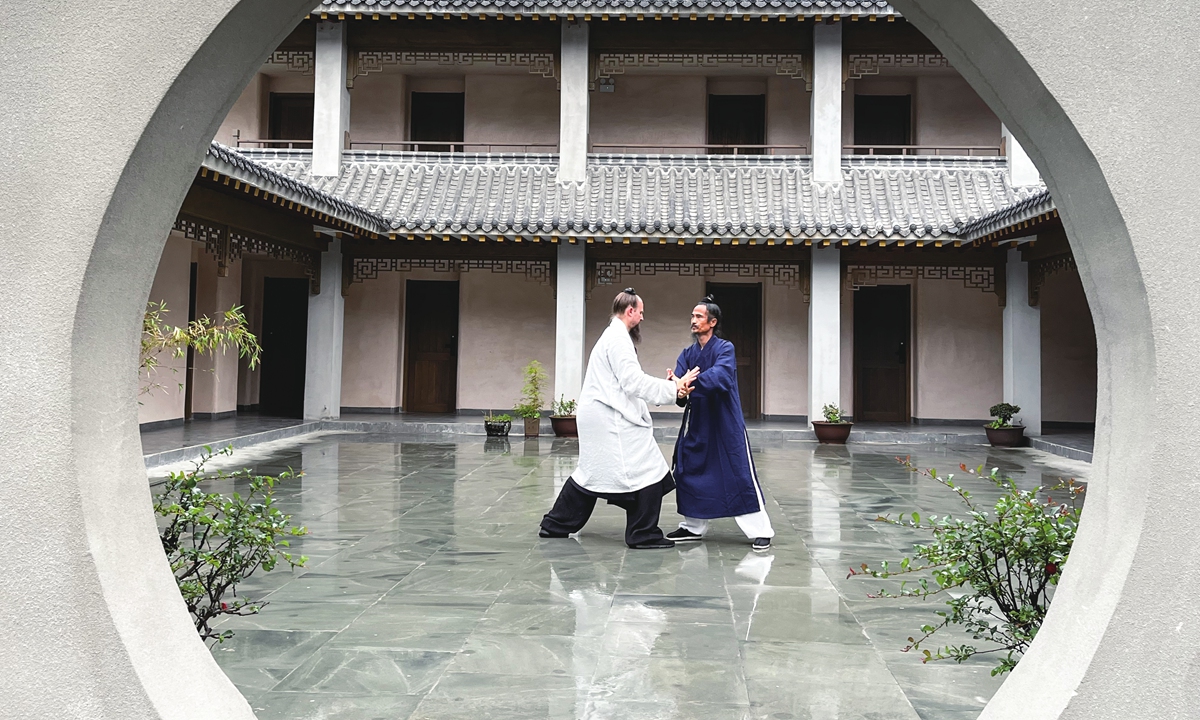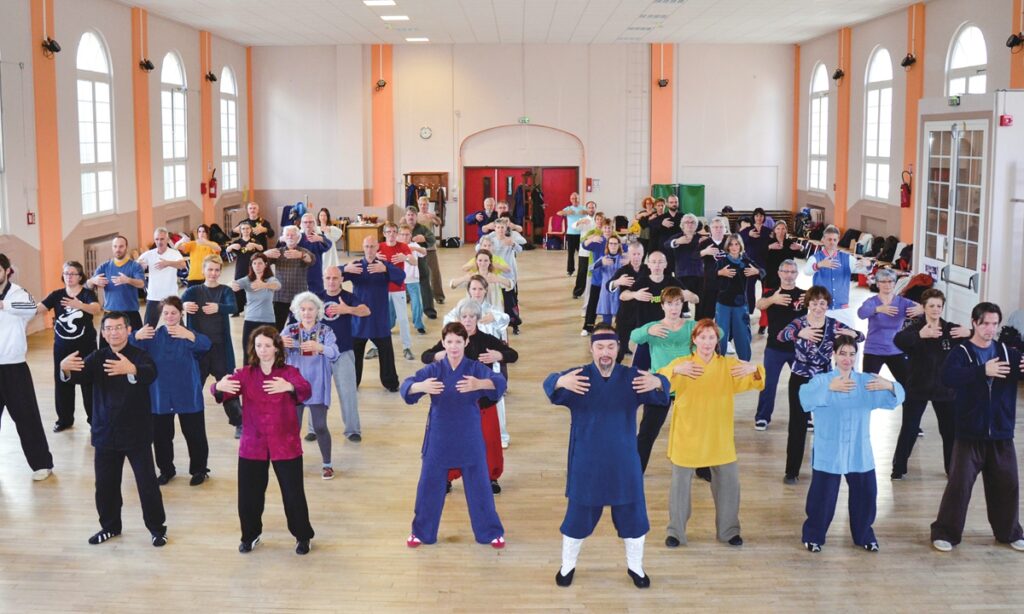Foreign disciples
Located in Shiyan, Central China’s Hubei Province, the Wudang Mountains are renowned for their gorgeous natural landscapes, large ancient temples scattered among the hills, long-standing Taoist culture and profound Wudang martial arts.
The place often appears in various martial arts novels and films. Some scenes in the movie The Karate Kid, starring Chinese action star Jackie Chan, were shot at famous places among the mountains such as the Golden Hall and Nanyan Palace.
In December 1994, an ancient building complex at Wudang was listed as a UNESCO World Heritage Site because of the religious significance and architectural achievements of the buildings within the complex, such as the Yuxu Palace.
“The ancient building complex in Wudang represents the highest standards of Chinese art and architecture over a period of nearly 1,000 years,” the UNESCO website says.
As the birthplace of Wudang martial arts and Chinese Taoism, the Wudang Mountains have become a pilgrimage site for Wudang martial artists, especially Tai Chi practitioners from China and abroad.
As early as 2007, along with the Great Wall, the Wudang Mountains were included in the top 10 most popular scenic spots in China that Europeans want to visit.
Gift for life and mind
Ingo, 52, from Germany is one of best representatives of foreigners who are interested in Tai Chi and Taoism. He came to Wudang in May to gain a deeper understanding of Chinese martial arts and traditional culture.
Ingo, who is currently attending a four-week program at the Wudang Liyang Internal Kung Fu Academy, met his master Tian Liyang while the latter was on an overseas teaching tour.
Tian, a 15th-generation disciple of the Xuanwu Lineage of Wudang martial arts, has practiced this form for over three decades.
Tian began to recruit foreign disciples in 1995. Since 1999, Tian has started to go to Europe twice a year on teaching tours, staying for two or three months each time, to teach Wudang martial arts and culture.
After joining a Tai Chi program taught by Tian in Germany, Ingo decided to go to Wudang for further training.
“I came to Wudang and went deeper into the martial arts of Tai Chi about 12 or 13 years ago,” Ingo said.
Since then, Ingo has flown to Wudang to practice Tai Chi and other martial arts almost every year.
Ingo told the Global Times that he has learned a lot from his master and has enjoyed great improvement in both his physical and mental health.
“I was searching for something that would be good for my mind and body, finally I found Tai Chi,” Ingo said.
“It is not only about the body movement and gestures, but at the same time, it also connects with Chinese philosophy and the inner workings of myself.”
“After practicing Tai Chi, I feel more in contact with people, and more aware of my inner world. I don’t need to be outside so much anymore,” Ingo recalled.
“Shifu (master) always told me that I should make the outside world become smaller and my inner world become bigger, and I recognize this right now.”
Tian told the Global Times that martial arts and Taoist health culture are extremely welcomed in European countries.
“In the process of teaching these overseas students, basically after each class, some people would say to me that I was not teaching them movements mechanically, but giving them a very great gift for life and mind,” Tian recalled.
There is a tradition in Taoism and martial arts in Wudang that “in the outside world, one should practice movements, while in the inner world, one should cultivate their spirit,” he said.
“The cultural background and Taoist thought are very meaningful to their lives.”
Wudang martial arts philosophy and Taoist health-preserving culture are important factors that attract overseas tourists and martial arts learners.
To meet the high demand from overseas students, Tian has offered eight to 10 short-term online courses every year since 2010 to better promote Chinese martial arts and traditional culture.
Tian told the Global Times that his students are from all over Europe, and many of them have opened martial arts schools themselves. As of now, he has more than 20,000 overseas students learning Wudang martial arts and ways to maintain good health.

Jake Lee Pinnick (left) is practicing martial arts with his master at a martial arts school at the foot of the Wudang Mountaions. Photo: Lu Yameng/GT
Promoting traditional culture
In recent years, exchanges between Wudang and overseas countries have been on the rise, paving the way for Wudang martial arts to go abroad.
The Wudang Martial Arts Association has established 27 overseas martial arts branches around the world in countries such as the UK, France, Mexico, Canada, Russia and the US, introduced a public relations official from the Wudang Special Zone Working Committee.
More people around the world are becoming interested in Tai Chi, qigong, Wudang martial arts and Taoist culture, which helps attract more foreigners to the region for a short-term travel or long-term stays.
At present, there are 29 martial arts schools around Wudang. During a peak period in August 2019, there were 947 domestic students and 472 foreign students studying at these schools. Foreign students accounted for one-third of the total number of students, the official introduced.
Jake Lee Pinnick, who was born in Kewanee, Illinois in the US in 1990, came to Wudang in 2010 to learn martial arts. Now he has been practicing Wudang martial arts at the foot of the Wudang Mountains for over a decade. Not only did he marry a Chinese woman in 2014 and had a lovely daughter several years later, but also became a foreign martial arts teacher at a local martial arts school.
In 2010, Pinnick registered for a five-year Wudang traditional martial arts training program run by his master Yuan Xiugang at the Wudang Taoist Traditional Kung Fu Academy.
Yuan is one of the 15th-generation disciples in the Zhang San Feng Lineage of Wudang martial arts. After five years of training, Jack graduated and became a 16th-generation disciple in the lineage.
“I want to promote martial arts to more people no matter if they are in China or in other countries or back in America,” Pinnick said.
“There was a moment in my second or third year that I was in Wudang where I started thinking that this practice is not just for me. I felt like it became my responsibility to teach more people,” he said.
“A lot of people don’t have the opportunity to come so far from home and do something for so long, to study martial arts and to learn the culture behind this.”
In the minds of these foreign disciples, Wudang martial arts not only strengthens the body, but also helps increase their understanding of Taoist culture, one of the pillars of traditional Chinese culture.
Over the last several years, Pinnick has been teaching overseas students about martial arts and traditional Chinese culture via online courses or in person classes.
In his spare time, he practices traditional instruments such as dongxiao, a vertical end-blown flute which is generally made of bamboo.
He has even written a book in English on how to play the instrument, so he could introduce it to more foreigners.
“In this book I collected together all the songs that I learned and played and wrote out, from basic to advanced, the different techniques the learners have to do. And I am still updating the book and adding more songs into it,” Pinnick said.
In addition, he is also interested in classic Chinese texts such as Tao Te Ching and Huangdi Neijing, and is exploring ways to explain these texts using simple language for foreigners to help them understand the philosophy in these texts. He is becoming an envoy of cultural exchanges between China and foreign countries.
“In Wudang, you have external training and internal training. For example, you will have kung fu training, but at the same time, you also have Tai Chi, qigong and meditation, and things that improve your inner peace,” Pinnick said, explaining why he started to learn traditional Chinese culture.
Despite studying martial arts for 13 years, Pinnick thinks that he is still at the beginning and there is still much to learn in the future.
Pinnick said that the most difficult thing in learning martial arts is maintaining a good outlook, a good perspective on life, and not allowing small problems to become big problems.
“If you meditate in the mountains by a river, it’s very easy to find peace, but it’s very difficult to bring that peace back home. Sometimes that’s difficult, but I think it’s a practice that’s worth continuing,” Pinnick said.
“With my goal as a disciple and as someone who finds this practice as my lifetime passion, I hope to eventually open a school here in China and one in America. I really want to be a bridge between cultures,” he said.
(Global Times)




